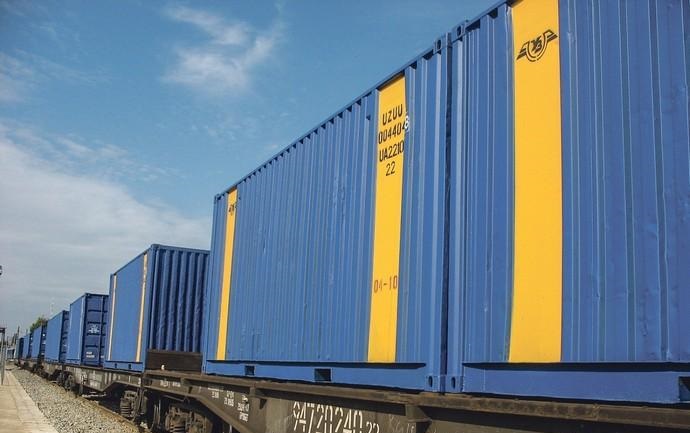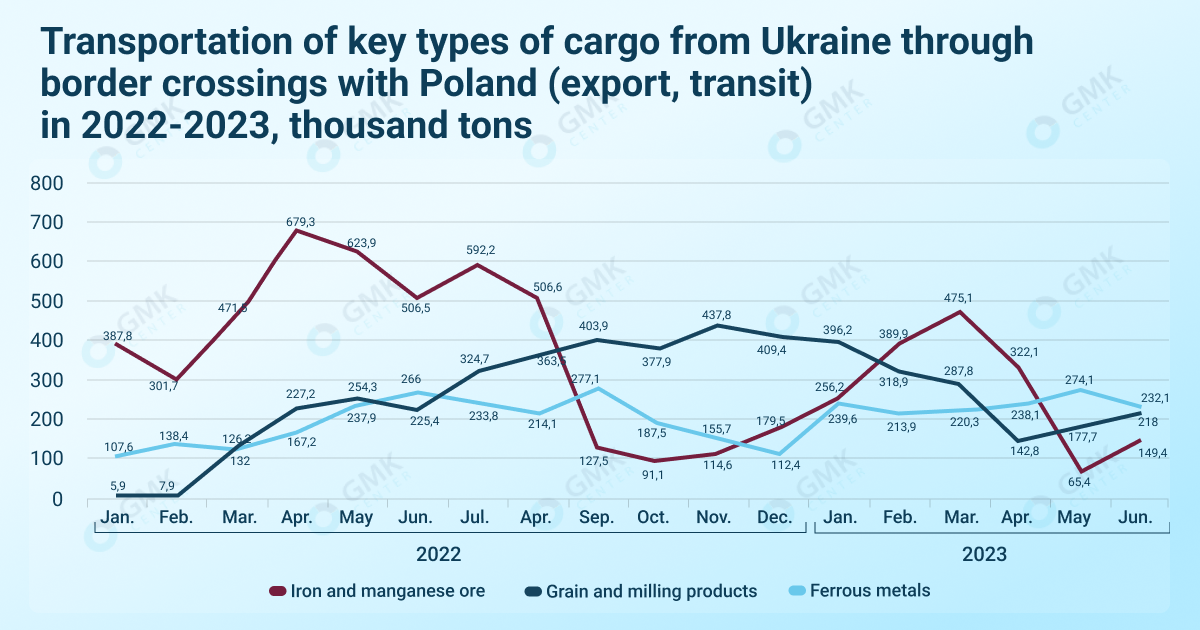Doing business

In the conditions of a full-scale war, Ukrainian exports and imports largely take place through the western border crossings with Poland, where railway transportation plays a key role. As it turned out, neither the Ukrainian nor the Polish infrastructure was ready to process the amount of cargo that was previously transported through the seaports that are currently blocked. In particular, Polish infrastructure is designed more for imports than for exports.
In 2022, 16.9 million tons of cargo were transported through railway border crossings between Ukraine and Poland, which is 4.5 million tons or 36.7% more than in 2021. In general, freight transportation by rail in Poland in 2022 increased by 2.1% – to 248.6 million tons.

There are six railway border crossings between Ukraine and Poland, but only four are operational. Their throughput per day is as follows:
«We have problems at the Yagodyn – Dorokhusk and Mostyska-2 – Medika points. More than 10 Polish carriers work at each of them, and in the conditions of limited track capabilities of border stations, the problem is the priority of the Polish operator’s provision of thread infrastructure for transportation to Polish carriers. Moreover, since the beginning of the war, the carrying capacity of Polish border crossings has not changed significantly. From our side, there are fewer problems, because – is the only operator that coordinates all work on the transfer of goods at the border. However, in the conditions of limited track capabilities of border stations, it is difficult for us to dose the cargo flow for a large number of recipients in the section of different nomenclature», says Valeriy Tkachev, deputy director of Ukrainian Railways’ (UZ) commercial work department.

The main technical reasons for the limited ability to transport export goods through the western crossings:
According to the Program for the Development of Railway Stations and Crossings Bordering EU Countries and Moldova for 2022-2025, it is planned to increase the number of border crossings with Poland by three: Khyriv – Starzhava – State Border, Rava-Ruska – Grebenne, Khyriv – Nyzhankovichi – State Border . Two railway sections on the border with Poland have already been restored: Derzhkordon – Starzhava – Khyriv – Nyzhankovichi – Derzhkordon (line 102) and Khyriv – Sambir.
«The commissioning of new border crossings with Poland depends on the cargo flows that are formed and are limited by the wishes of the Polish side. At the moment, the current transitions are loaded by 40-60%, on average 58%. Therefore, the issue is not the capacity of the junctions, but the ability of the European railway infrastructure to absorb our export flow of goods. If the Izov – Grubeshuv point works at approximately 62.5%, then Rava-Ruska – Verkhrata is practically idle, cargo transfer is less than 5% of the throughput capacity,» explains Tkachev.
The volume of export cargo transportation depends not only on the throughput, but also on the market situation and other factors. For example, now neighboring EU countries do not want to allow Ukrainian grain imports. Also, Ukrainian shippers were faced with quarterly indexation towards tariff increases by European railway carriers and price speculation in conditions of increased demand.
Among the bureaucratic border problems, the following should be noted:
«There are problems with the speed of movement of goods, which is half the speed we are used to in Ukraine. We also have to face overly complicated customs procedures that take extra time,» says commercial director of Metinvest Dmytro Nikolayenko.
A member of the logistics committee of the European Business Association Yuriy Shchuklin notes the following administrative problems of railway logistics between Ukraine and Poland:
The pressure of the export flow of Ukrainian goods on the border infrastructure required urgent action. Among the infrastructure projects implemented by Ukrainian Railways on the border with Poland, the following should be noted:
On August 28, the Polish operator Polskie Koleje Państwowe Spółka Akcyjna (PKP S.A.) and Ukrainian Railways signed a document on cooperation in the development of passenger and freight rail transportation between the countries in order to increase the export-import potential. This is the first agreement of this level between the railways of the two countries since 1994.
«Together, we will continue to develop the border infrastructure and increase passenger and cargo traffic between our countries, which will ultimately have a positive effect on our railways and the national economies of Ukraine and Poland,» said the Chairman of the Board of UZ Evgen Lyashchenko.
At the same time, the situation with queues at railway crossings improved, but the crossing capacity did not. Moreover, according to Shchuklin, it improved not thanks to, but against the aspirations of Ukrainian Railways. Truck owners additionally purchased more than 6,000 dump trailers to the already existing rolling stock.
The problem of limited capacities partially found its solution in the actions of Ukrainian business. During 2022-2023, about a hundred terminals were built on both sides of the border, which operated on 1435 and 1520 mm tracks. UZ allowed more than 30 private companies to develop border transshipment complexes.
According to Oleksandr Tkachuk, director of the development of the Levada Cargo terminal network (a subsidiary of Lemtrans), first of all, compared to 2022, the cargo base at the western crossings decreased (with the opening of the grain corridor, cargo went to the Black Sea and the Danube), therefore we don’t feel that pressure. Thanks to the organizational measures of carriers, state organizations and institutions, cargo owners, throughput has improved. However, not enough to meet all demand.
«It is necessary to give credit that the opening of new crossings, terminals, experiments with the organization of train transfer brought some positive, but cargo owners are not satisfied due to the significant transit time of transportation. Especially in 2022. This year it became calmer, but most likely due to the reduction of the cargo base at the western crossings and due to the establishment of stable business relations with European carriers and ports,» says Tkachuk.
According to Yuriy Shchuklin, the following should be done to improve railway logistics between Ukraine and Poland:
Throuh the Connecting Europe Facility (CEF) program, the European Union will allocate funds to UZ for the development of border crossings. They will be aimed, in particular, at the development of crossing points with Poland: Yagodyn – Dorogusk and Mostyska II – Medyka. The total amount of grant funds that will be allocated after the conclusion of the agreement will amount to more than €40 million. It is expected that the 2023-2025 program will also include projects for the development of Eurotrack in the sections Chop – Uzhgorod, Maceiv – Kovel, station tracks of 1435 mm and the development of intermodal Liska terminal at Chop station.
For its part, Poland wants to expand border infrastructure to increase Ukrainian agricultural exports at the expense of EU funds. The expansion of the border terminals for heavy trucks (Dorogusk – Yagodyn, Grebenne – Rava-Ruska, Korchova – Krakowiec) and the railway infrastructure in Przemyśl requires at least €500 million. Another €500 million should be spent on the modernization of railway border crossings between Poland and Ukraine, construction of terminals for trucks and development of infrastructure for managing freight traffic at the border.
Also the issue of the construction of Eurorail on the border areas and in the direction of the ports of the Baltic countries, which are currently underloaded, is discussed. The implementation of such projects is being decided on the border areas, but Ukraine is more interested in a broad-gauge line to the Baltic countries, where railway tracks are 1,520 mm wide. That is why the European Business Association turned to to Poland with a proposal to consider the construction of a broad-gauge line that will connect the railway networks of Ukraine and Lithuania, as well as the port of Gdansk. The implementation of the project may take up to five years. However, Poland did not support this idea, since the current plans of the European Union do not provide for subsidizing the expansion of the 1520 mm railway infrastructure. Although in 2022, representatives of the Polish authorities themselves proposed to lay a broad-gauge line to Gdańsk for the transportation of Ukrainian exports. But there are still no decisions regarding the broad-gauge line to the ports of the Baltic countries.
In the future, it is possible to expand the construction of a 1435 mm track within border areas and even inland within the Trans-European Transport Network (TEN-T) projects. In order to integrate into the European railway network, almost 3,300 km of European tracks can be built on the territory of Ukraine. The first priority of the project is to expand the connection on the section Mostyska – Lviv, where it is possible to make a two-track transformation from 1520 mm to 1435 mm. The expected cost of modernization is €432 million.
«Investments in transport infrastructure between Ukraine and the EU, between Ukraine and Poland are investments in the future of the Ukrainian economy, in economic integration in the EU. Therefore, our Polish partners have a unique chance to redirect the majority of export flows from Ukraine through their country for decades,» emphasizes Stanislav Zinchenko, CEO of the GMK Center.
Source https://gmk.center/ua/